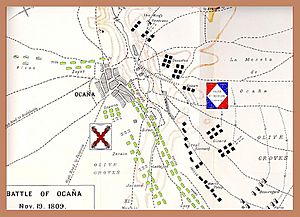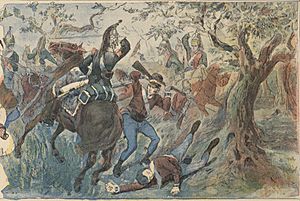Battle of Ocaña facts for kids
Quick facts for kids Battle of Ocaña |
|||||||
|---|---|---|---|---|---|---|---|
| Part of the Peninsular War | |||||||
 |
|||||||
|
|||||||
| Belligerents | |||||||
| Commanders and leaders | |||||||
| Strength | |||||||
| 24,000-27,000 infantry 5,000-6,000 cavalry 50 guns |
44,000-45,000 infantry 6,000-7,000 cavalry 60 guns |
||||||
| Casualties and losses | |||||||
| 1,700-2,000 killed or wounded | 4,000-5,000 killed or wounded 14,000-26,000 captured 45 guns captured |
||||||
The Battle of Ocaña was a major battle fought on November 19, 1809. It took place near the town of Ocaña in Spain. This battle was part of the larger Peninsular War, which involved French forces against Spanish and other allied armies.
In this battle, the French army was led by Marshal Soult and King Joseph Bonaparte. They fought against the Spanish army commanded by General Aréizaga. The Spanish army suffered a huge defeat, losing many soldiers. This loss was mainly because the French used their cavalry (soldiers on horseback) very effectively. It was one of the worst defeats for a Spanish army on their own land.
Contents
What Happened Before?
The fighting in Spain in late 1809 was part of the Spanish campaign. It began after the Battle of Talavera.
Armies Get Ready
The Spanish plan for autumn 1809 was to attack Madrid, the capital, from both the north and the south. They asked for help from the British general, Arthur Wellesley, Viscount Wellington. However, Wellington had not received much cooperation from the Spanish during the Talavera campaign. So, he decided not to join them this time.
The French were almost caught by surprise by the Spanish attack from the south. By November 9, the southern Spanish army was very close to Madrid. Only about 7,000 French soldiers were in their way. But then, General Aréizaga of the Spanish army got nervous and stopped for three days. When he finally moved towards Madrid again, he met two French divisions and had to pull back. After several days of marching back and forth without success, the French army was fully ready. They had gathered their forces and were moving to stop the Spanish army.
Who Fought?
The battle involved a large number of soldiers from both sides. Here's a look at the main forces.
The Spanish Army
General Aréizaga commanded the Spanish army. He had about 51,000 to 52,000 soldiers. These included eight divisions of infantry (foot soldiers) and four divisions of cavalry (soldiers on horseback). They also had 60 cannons, operated by 1,500 artillery soldiers. Some reports say the Spanish army might have had even more men, up to 60,000.
- Spanish Infantry Divisions:
- 1st Division led by Lacy (about 7,700 soldiers)
- 2nd Division led by Vigodet (about 7,100 soldiers)
- 3rd Division led by Girón (about 5,200 soldiers)
- 4th Division led by Castejon (about 6,400 soldiers)
- 5th Division led by Zeraín (about 5,900 soldiers)
- 6th Division led by N. Jacome (about 7,600 soldiers)
- 7th Division led by Francisco Copons (about 5,100 soldiers)
- Vanguard (front-line) led by Zayas (about 6,000 soldiers)
- Spanish Cavalry Divisions:
- Overall cavalry led by Freire de Andrade (about 5,800 soldiers)
- 1st Division led by J. Bernuy
- 2nd Division led by J. Rivas
- 3rd Division led by Miguel March
- 4th Division led by Osorio
The French Army
While King Joseph was officially in charge, Marshal Soult was the real commander of the French army. The French had about 24,000 infantry, 5,000 cavalry, and 1,500 artillery soldiers with 50 cannons.
- French Corps and Divisions:
- IV Corps led by Sébastiani
- Division led by Leval (included Dutch, German, and Swiss soldiers)
- Division led by Werlé (included Polish soldiers)
- V Corps led by Marshal Mortier
- Division led by Girard
- Division led by Gazan
- Cavalry Divisions:
- Division led by Milhaud (about 1,800 dragoons)
- Division led by Antoine Paris d'Illins (about 1,000 light cavalry)
- Division led by Charles Victor Woirgard (Beauregard) (about 1,500 cavalry)
- Royal Guard Cavalry: (about 700 soldiers)
- Central Reserve: led by Jean-Joseph, Marquis Dessolles (about 7,000 soldiers)
- IV Corps led by Sébastiani
The Battle Begins
Cavalry Clash
On November 18, the day before the main battle, a very large cavalry fight happened. Three of the Spanish cavalry divisions, about 4,000 horsemen, tried to clear a path for their army to retreat. The French cavalry attacked them. The French light cavalry, led by Paris, charged first and broke through the Spanish front line. Then, Milhaud's dragoons (heavy cavalry) attacked and completely drove the Spanish cavalry away. The French lost less than 100 men, while the Spanish lost hundreds, with 80 captured.
Where They Stood
West of Ocaña town, the Spanish placed Zayas y Chacón's Vanguard and Rivas's cavalry. From Ocaña towards the east, the Spanish commander arranged his main forces. The far right side of their line was held by Freire's remaining three cavalry divisions. From there to Ocaña, the infantry divisions of Lacy, Castejon, Girón, and Vigodet formed the front line. Their battalions were set up in two rows. Behind Castejon, Jacome's men were in reserve, with Zerain supporting Giron and Copons backing up Vigodet.
The French Royal Guard and one brigade of Dessolles were north of Ocaña, facing a deep valley. Next to them, to the east, was Louis Rey's brigade. Gazan and Girard from the V Corps, Leval and Werlé from the IV Corps, and the rest of the cavalry completed the French line to the east. Marshal Soult gathered 30 cannons near Dessolles and the V Corps' positions.
The Main Fight
On November 19, the French cannons fired heavily at the center of the Spanish line. Leval's troops attacked Castejon's division, and Werlé's troops attacked Lacy's division. At first, the Spanish line bent back a little. But then, as the French IV Corps paused for their cannons to move up, the two Spanish divisions pushed forward and started firing their muskets. The Dutch, German, and Polish soldiers in the French line began to move back. Soult quickly sent Girard's division to help the struggling IV Corps.
While this was happening, Milhaud's dragoons, supported by Woirgard and Paris, quickly moved towards the exposed right side of the Spanish army. Hidden by olive trees, they suddenly appeared in front of Freire's cavalry. The French charged and quickly defeated the Spanish horsemen. Milhaud, Paris, and Woirgard then smartly turned their cavalry units and attacked the unprotected side of Lacy's infantry. Soult then ordered the entire French front line to advance. The many French cannons fired even more fiercely at the Spanish line.
The Spanish divisions were now facing infantry attacking them from the front and cavalry attacking their side. They quickly broke apart and ran away. At this critical moment, Dessolles and the Royal Guard rushed across the valley and burst into Ocaña. This cut off the Spanish left side from their collapsing center and right. As the Spanish army fled south, only Zayas's division remained organized to cover their retreat. But Soult's cavalry chased them and broke Zayas's division later that day.
What Was the Outcome?
The French won a huge victory. They captured 14,000 Spanish soldiers, 50 cannons, 30 flags, and all the Spanish army's supplies. Another 4,000 Spanish soldiers were killed or wounded. The French lost about 2,000 soldiers killed or wounded. Paris, a French cavalry commander, was killed, and Girard was wounded.
This terrible defeat left southern Spain open for the French to take control. Just a week later, the northern Spanish army was also defeated at the Battle of Alba de Tormes. This cleared the way for the French to conquer Andalusia, a region in southern Spain.
What Happened Next?
The Spanish campaign in late 1809 continued with another attempt to attack Madrid, which led to the Battle of Carpio.
See also
 In Spanish: Batalla de Ocaña para niños
In Spanish: Batalla de Ocaña para niños
- Pieter Hendrik van Zuylen van Nijevelt


